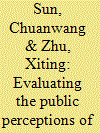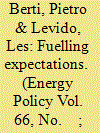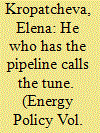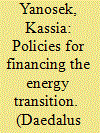|
|
|
Sort Order |
|
|
|
Items / Page
|
|
|
|
|
|
|
| Srl | Item |
| 1 |
ID:
133115


|
|
|
|
|
| Publication |
2014.
|
| Summary/Abstract |
Building energy efficiency rating systems have been established worldwide to systematically manage the energy consumption of existing buildings. This study aimed to develop a new energy efficiency rating system for existing residential buildings from two perspectives: (i) establishment of reasonable and fair criteria for the building energy efficiency rating system; and (ii) establishment of comparative incentive and penalty programs to encourage the voluntary participation of all residents in the energy saving campaign. Based on the analysis of the conventional energy efficiency rating system for existing residential buildings, this study was conducted in five steps: (i) data collection and analysis; (ii) correlation analysis between the household size and the CO2 emission density (i.e., CO2 emission per unit area); (iii) cluster formation based on results of the correlation analysis using a decision tree; (iv) establishment of a new energy efficiency rating system for existing buildings; and (v) establishment of incentive and penalty programs using advanced case-based reasoning. The proposed system can allow a policymaker to establish a reasonable and fair energy efficiency rating system for existing residential buildings and can encourage the voluntary participation of all residents in the energy saving campaign.
|
|
|
|
|
|
|
|
|
|
|
|
|
|
|
|
| 2 |
ID:
132674


|
|
|
|
|
| Publication |
2014.
|
| Summary/Abstract |
After the Fukushima nuclear accident, more and more attention has been paid to the safety issues of nuclear power in China, even though it is a clean and necessary substitution to coal power. Due to the consideration about the uncertainty of nuclear safety, the local citizens may resist the nuclear power programs in their neighborhood, as indicated by the anti-nuclear movement in Jiangmen 2013. This phenomenon is often related to the public perceptions of "not-in-my-back-yard" (NIMABY). The explosion of anti-nuclear movements will impose adverse effects on the nuclear power decision-making in China. Based on the Contingent Valuation Method (CVM), we evaluate the public Willingness-To-Pay (WTP) for avoiding the construction of nuclear power plants in their neighborhood. Moreover, we analyze whether more information about nuclear energy could improve the public acceptance. Our results show that the comprehensive information will decrease the public risk perception of nuclear power and increase the public support for nuclear power policy. This paper further suggests that China×s decision makers should improve policy transparency and encourage the public involvement of nuclear energy decision making.
|
|
|
|
|
|
|
|
|
|
|
|
|
|
|
|
| 3 |
ID:
127883


|
|
|
|
|
| Publication |
2014.
|
| Summary/Abstract |
Controversy over EU-wide biofuel policy resonated within the UK, fuelling policy disagreements among UK public authorities. They disagreed over how to protect a space for future second-generation biofuels, which were expected to overcome harm from first-generation biofuels. The UK government defended rising targets for available biofuels as a necessary stimulus for industry to help fulfil the UK's EU obligations and eventually develop second-generation biofuels. By contrast, Parliamentary Select Committees opposed biofuel targets on grounds that these would instead lock-in first-generation biofuels, thus delaying or pre-empting second-generation biofuels. Those disagreements can be explained by different institutional responsibilities and reputational stakes towards 'promise-requirement cycles', whereby techno-optimistic promises generate future requirements for the actors involved. The UK government's stance illustrates a 'policy-promise lock-in', a dilemma whereby promised support is a requirement for credibility towards technology innovators and thus technoscientific development - but may delay the redirection of support from incumbent to preferable emerging technologies. Thus the sociology of expectations - previously applied to technological expectations from technology innovators - can be extended to analyse public authorities.
|
|
|
|
|
|
|
|
|
|
|
|
|
|
|
|
| 4 |
ID:
127865


|
|
|
|
|
| Publication |
2014.
|
| Summary/Abstract |
Russian energy policy is usually considered in the regional context - in terms of its energy power capability and strength vis-à-vis the EU and the post-Soviet states. This study shows that in order to understand Russia's energy power, even in the regional context of its relations with the EU, it is necessary to consider the impact of international changes in the energy sector. The oil and gas shale "revolutions" represent such a global factor of influence. Even if their consequences are not yet clear, they have already become an important challenge for Russian energy policy and power. This policy-oriented article, guided by neoclassical realism, analyzes what the shale "revolutions" mean for Russia's energy policy and its power capabilities vis-à-vis the EU, how the Russian political elite perceive this development and how Russia reacts to it. In this context, Russian power capabilities look more moderate.
|
|
|
|
|
|
|
|
|
|
|
|
|
|
|
|
| 5 |
ID:
115856


|
|
|
| 6 |
ID:
127249


|
|
|
|
|
| Publication |
2014.
|
| Summary/Abstract |
This study analyses battery electric vehicles (BEVs) in the future German power system and makes projections of the BEVs hourly load profile by car size ('mini', 'small', 'compact' and 'large'). By means of a power plant dispatching optimisation model, the study assesses the optimal BEV charging/discharging strategies in grid-to-vehicle (G2V) and vehicle-to-grid (V2G) schemes. The results show that the 2% rise in power demand required to power these BEVs does not hamper system stability provided an optimal G2V scheme is applied. Moreover, such BEV deployment can contribute to further integrating wind and solar power generation. Applying a V2G scheme would increase the capacity factors of base and mid-load power plants, leading to a higher integration of intermittent renewables and resulting in a decrease in system costs. However, the evaluation of the profitability of BEVs shows that applying a V2G scheme is not a viable economic option due to the high cost of investing in batteries. Some BEV owners would make modest profits (€6 a year), but a higher number would sustain losses, for reasons of scale. For BEVs to become part of the power system, further incentives are necessary to make the business model attractive to car owners
|
|
|
|
|
|
|
|
|
|
|
|
|
|
|
|
| 7 |
ID:
113148


|
|
|
|
|
| Publication |
2012.
|
| Summary/Abstract |
Historically, energy transitions have occurred gradually over the span of several decades, marked by incremental improvements in technologies. In recent years, public interest in accelerating the next energy transition has fueled a clean-energy policy agenda intended to underpin the development of a decarbonized energy economy. However, policies to date have encouraged investors to fund renewable energy projects utilizing proven technologies that are not competitive without the help of government subsidies. A true transition of the energy mix requires innovations that can compete with conventional energy over the long term. Investments in innovative technology projects are scarce because of the "commercialization gap," which affects projects that are too capital-intensive for venture capital yet too risky for private equity, project, or corporate debt financing. Accelerating innovation through the commercialization gap will require governments to allocate public dollars to, and encourage private investment in, these riskier projects. Policy-makers will face a trade-off between prioritizing policies for accelerating the energy transition and accounting for the risks associated with innovation funding in a tight budgetary environment.
|
|
|
|
|
|
|
|
|
|
|
|
|
|
|
|
| 8 |
ID:
127995


|
|
|
|
|
| Publication |
2014.
|
| Summary/Abstract |
The West Coast Region (WCR) of the Western Cape Province in South Africa is earmarked for 13 onshore wind farm projects totaling approximately 700 wind turbines. The developed world debate about the social acceptance of wind farm projects has impeded and illuminated a number of these developments. This paper is aimed at understanding people's reaction to proposed wind farm projects in the WCR - a region of a developing country - and to investigate whether the reasoning behind opposition to or acceptance of wind farm projects is similar to the discourse on the topic by scholars in the developed world. Quantitative and qualitative methods were used to collect primary data by semi-structured interviews and a questionnaire survey. A spatial dimension was added through a map-based approach. Reactions by WCR residents to the wind farm projects were mainly positive, although some opposition was detected. International scholarship holds that place attachment serves as a reason for opposition to wind farm projects. Although most of the WCR residents had strong place attachments to their region, most of the respondents also supported the proposed wind farm projects.
|
|
|
|
|
|
|
|
|
|
|
|
|
|
|
|
| 9 |
ID:
127200


|
|
|
|
|
| Publication |
2014.
|
| Summary/Abstract |
In order to evaluate the alternative technologies for producing hydrogen in Korea stage by stage, we searched for impact factors, calculated the weights of them and evaluated the hydrogen production technologies in Korea using analytic hierarchy process (AHP) approach. The AHP is a useful method for resolving multi-criteria decision making problems. We investigated 4 criteria (technical characteristics, economic efficiency, marketability, internal capability) and 11 sub-criteria (scale, efficiency, key barriers, carbon dioxide reduction, current production cost, expected production cost in 2017, feed-stock, technical maturity, R&D competitive level, technology gap with competing agencies, and domestic infrastructure). And the alternatives are natural gas reforming technology, coal gasification technology, biomass gasification technology, water electrolysis technology, thermochemical production technology, photoelectrochemical hydrogen production technology, and biological hydrogen production technology. In order to maintain the objectivity of the analysis result and observe the difference among the groups, the questionnaire survey targets were divided into the R&D professional group and policy professional group. This result of study is expected to serve as important basic information in the establishment of a national R&D strategy to prepare for the imminent hydrogen economy era.
|
|
|
|
|
|
|
|
|
|
|
|
|
|
|
|
|
|
|
|
|